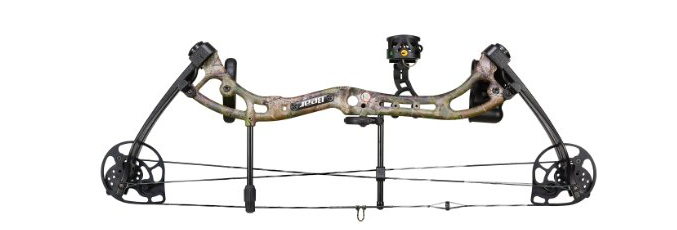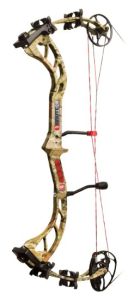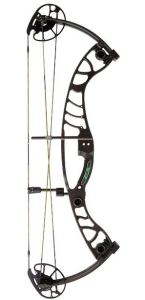
Table of Contents
- My #1 Recommendation
- Best Compound Bow for Beginners
- Best Youth Compound Bow
- Best Compound Bow for Hunting
- Best Compound Bow for Competition Target Shooting
- Most Powerful Compound Bow
- Best Compound Bow for the Money
- Best Compound Bow Under $500
- Best Compound Bow under $300
- Best Compound Bow under $200
- Best Compound Bow Brands
- Choosing the Right Compound Bow
- Conclusion
In this guide, you’ll find an overview of the technology used in modern bows, the different options you have, and recommendations for some of the top compound bows within your budget.
My #1 Recommendation
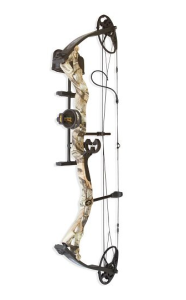 It’s difficult to choose a single compound bow as the best overall, but what I recommend in the majority of cases is the Diamond Infinite Edge. With its insane 13″ to 30″ draw length range, and 5 to 70 lb. draw weight range, the Edge is a bow that is exceptionally user-friendly. Weighing only 3.1 pounds, it can fire an arrow at 310 FPS, making it the perfect hunting companion or target shooter. If you buy the package, it will come with a 3 pin sight, quiver, peep sight, Hostage XL arrow rest, and more. And if you don’t want to take my word for it, Amazon.com has over 100 reviews worth reading. All in all it is a great, highly versatile bow.
It’s difficult to choose a single compound bow as the best overall, but what I recommend in the majority of cases is the Diamond Infinite Edge. With its insane 13″ to 30″ draw length range, and 5 to 70 lb. draw weight range, the Edge is a bow that is exceptionally user-friendly. Weighing only 3.1 pounds, it can fire an arrow at 310 FPS, making it the perfect hunting companion or target shooter. If you buy the package, it will come with a 3 pin sight, quiver, peep sight, Hostage XL arrow rest, and more. And if you don’t want to take my word for it, Amazon.com has over 100 reviews worth reading. All in all it is a great, highly versatile bow.
Best Compound Bow for Beginners
There are many things to consider as a beginner compound purchaser and user. Before reviewing specific bows, let’s discuss these considerations.
Price
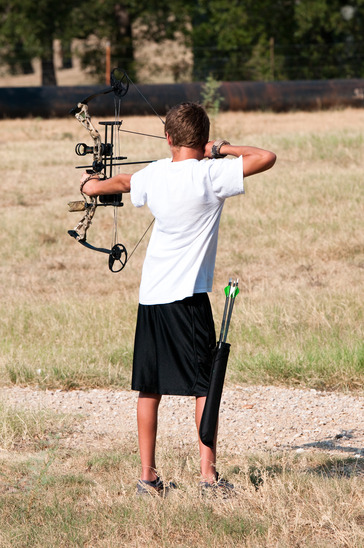 Let’s face it, you’re a beginner, and no matter how much information you find out there on the Internet or in this article, you will most likely end up trading in your old bow for a new one after a few years. This means your first bow should be adjustable, but solid enough to grow with experience. With this in mind, look for an inexpensive option for your first bow.
Let’s face it, you’re a beginner, and no matter how much information you find out there on the Internet or in this article, you will most likely end up trading in your old bow for a new one after a few years. This means your first bow should be adjustable, but solid enough to grow with experience. With this in mind, look for an inexpensive option for your first bow.
Most compound bows cost more than $500, but there are some great options that cost less than $400. Make no mistake, “entry level” compound bows are just as deadly as more expensive options.
FPS Speed Considerations
When choosing a bow based on FPS speed, keep in mind that the faster the bow shoots, the more aggressive the cam is going to feel and the more difficult it’s going to be to draw. There is no way around that. As a beginning archer, it’s best to avoid an aggressive draw while learning to shoot properly. Therefore, you should stick with a bow that has an advertised speed of below 330 FPS. Even a 320 provides more speed than you will likely need and can still be used to hunt some of the largest game in the world.
Brace Height
Brace actually doesn’t matter quite as much as it used to. Back when compound bows were just being manufactured, the models that had a lower brace height were more difficult to aim and shoot. They were harder to hold, harder to draw and aim, and more likely to slap your forearm when released.
Some believe it’s better to go for a brace height that’s seven inches or longer. Realistically, it probably won’t make such a noticeable difference, but if you want a range to look for, shoot for between six and eight inches.
What About Let-Off?
Let-off will affect how hard it is to draw the bow back and hold it in place as you aim. The higher the percentage, the easier the bow is to hold. Therefore, beginners want to go for a let-off that’s higher because they will have a lot more time and comfort as they learn how to aim and perfect their form.
If you’re a beginner, try to find a bow that’s between 75 and 80% let-off.
ATA Length and Weight
For hunting, the axle to axle length should be less than 33 inches and lighter than 4.3 pounds. Since you will be carrying the bow while you’re hunting, and might need to maneuver it in the bush or in a tree stand, compact sizes and lighter weight options will be a lot easier to handle.
If you dream of one day target shooting with Team USA, you will want a longer bow that will have better stability and less vibration. However as a beginner, don’t worry about this too much. Just be sure the bow isn’t too long (over 35 inches) and that it is light-weight so you don’t tire easily.
So which bow would I recommend for beginners?
Diamond Infinite Edge
 The Diamond Infinite Edge has an adjustable draw weight between 5 and 70 pounds, so you can adjust it after purchasing the bow. It has a draw length of 13-30 inches which will fit almost anyone. The brace height is 7 inches, which is right in between the recommended brace height for beginners. The IBO speed is 310 FPS, so it’s more than powerful enough for a beginner who wants to hunt large game or just practice with a target. The let-off is 75%, so it’s easy to hold the arrow in place and pull it back without too much strain. You’ll be able to practice a long time without your arms getting too tired! The AtA length is 31” and its weight is 3.1 pounds, so it’s user-friendly for beginners and experienced hunters.
The Diamond Infinite Edge has an adjustable draw weight between 5 and 70 pounds, so you can adjust it after purchasing the bow. It has a draw length of 13-30 inches which will fit almost anyone. The brace height is 7 inches, which is right in between the recommended brace height for beginners. The IBO speed is 310 FPS, so it’s more than powerful enough for a beginner who wants to hunt large game or just practice with a target. The let-off is 75%, so it’s easy to hold the arrow in place and pull it back without too much strain. You’ll be able to practice a long time without your arms getting too tired! The AtA length is 31” and its weight is 3.1 pounds, so it’s user-friendly for beginners and experienced hunters.
Best Youth Compound Bow
Keep in mind while looking for youth compound bows that purchasing one for an adult is a bit different than purchasing one for a child who is just getting into archery; they don’t care about brand, they care more about comfort and how easy it is to draw the bow back and hold it.
Some adults will make the mistake of purchasing the “best bow for youths” for their kids based on their preferences and not by carefully analyzing the qualities they should consider for their child. In these situations, kids end up with a bow they’re not able to shoot comfortably and lose interest in the sport entirely. To prevent this from happening, you should make a list of bows you find on the market that fit the bill and find a place where they can test them out before purchasing.
There are many different crucial factors to consider when looking for a compound bow for your child.
Age
Although both use youth bows, a four-year-old and a sixteen-year-old will have vastly different needs. There are many bows for young children that will last from the age of four to about ten, and then your child will likely need another youth bow. If you come across a phrase in a bow’s description that states ‘this is the only bow your child is going to need because it will grow with them,’ keep in mind that is only relevant for certain age ranges. If your child is starting at a young age, you will likely need to buy one or two more before adulthood.
Bow Mass Weight
Bow mass weight is a very important factor when choosing a compound bow for a small child. While older children can easily hold a youth bow, smaller kids are not going to be strong enough to hold a heavier one and they’ll need a lightweight bow.
It’s also important to note that some bow manufacturers don’t make lightweight compound bows for children. Be careful to check the specifications before you make a decision. Most importantly, ask your child how they feel about holding the bow. If they believe it’s too heavy, don’t buy it.
Draw Weight
When a young body that’s still growing is stressed, it can cause some serious health complications. Pulling too much weight might lead to over-developing some muscles and under-developing others. Doctors say that young shooters should not try to pull too much draw weight because their joints and muscles are still growing, and this can lead to long-term damage. Be careful to choose a bow that your child can pull back comfortably. Also, take caution to set the appropriate draw weight on the bow and adjust it as they grow rather than just leaving it at the manufacturer’s setting. For example, a child who is four should never pull a weight more than ten pounds. Take a look at the following chart to determine what the right draw weight is for your child.
It’s important to explain to your child that a good archer is not someone who can pull more weight, but someone who is accurate and consistent with their bow.
The following recommendations are based on the age and weight of the child.
Compound Bows for Children 4-8
The Martin Tiger is an excellent choice for children who are four to eight years old and between 55 and 100 pounds. It has a mass weight of 1.375 pounds, a draw length of 14”-24,” and a draw weight of 10-20 pounds. It is easy to use and easy to carry around.
Compound Bows for Children 8-14
The Diamond Atomic is a great option for kids who are four to ten years old and weighing 70 to 130 pounds. It has a total weight of 1.9 pounds, a draw length of 12”-24,” and a draw weight of 6-29 pounds. This makes it easy to use and a little more accurate. Kids who are older are going to care more about if they can go hunting or not, and this bow can be taken on small game hunting trips.
Compound Bows for Athletic Children
The Bear Archery Brave is a 26” compound bow that’s a step up from the Crosman Upland or Genesis bow. Its sports a slightly higher maximum draw weight between 15 and 25 lbs. For a right-handed compound bow, the Brave combines affordability and power that’s perfect for the athletic child. The Brave also has an equipped Whisker Biscuit (the arrow rest), 1-pin sight, and quiver. It comes in a couple of different colors which vary in cost but most versions are below $50 in value in total.
Best Compound Bow for Hunting
The SAS Siege is one of the best compound bows for those who are new to hunting. Most online reviewers seem to agree with over a hundred reviews and almost a perfect five-star rating! This bow has a draw length of twenty-nine inches, a draw weight of 40-55 pounds, an AtA of 41.5”, a let-off of 70%, a max speed of 206 FPS (which is plenty for hunting game animals), and is only four pounds. That makes it a pretty powerful bow that’s relatively light and ready for action!
Another great option for more advanced hunters who are looking for increased power and features is the Martin Archery Lithium. This powerful bow can fire an arrow up to 335 FPS, more than enough to tackle any game animals you will find. For the seasoned hunter who is willing to make an investment in his go-to weapon, this is the perfect bow.
Best Compound Bow for Competition Target Shooting
When it comes to compound bow shooting for competition, priorities are aim and comfort. The PSE Brute X Compound Bow is one of the fastest, smoothest bows on the market. It has a 60-70 pound draw weight, a speed of 320 FPS, a 31” AtA, a 7.25” brace height, and a 29” draw setting that will fit just about anyone. With a 75% let-off, it’s relatively easy to aim and shoot! The accuracy of this bow will astound you, and those who dare to compete against you even more so!
Most Powerful Compound Bow
 If you’re looking for the elusive compound bow that has a 400 FPS, you’re most likely not going to find it in the near future. With an FPS that high, you’d have to be Hercules to draw it back, which is no fun when you’re out on the game trail hunting. However, there is a bow that gets pretty close to that description, but you will have to pay a good price for it too.
If you’re looking for the elusive compound bow that has a 400 FPS, you’re most likely not going to find it in the near future. With an FPS that high, you’d have to be Hercules to draw it back, which is no fun when you’re out on the game trail hunting. However, there is a bow that gets pretty close to that description, but you will have to pay a good price for it too.
The PSE Prophecy is a definite vision of things to come. It has a 340 FPS that’s accurate, a brace height of six inches, an AtA of 32”, a let-off of 75%, a weight of 4.1 pounds, and a draw range of 25-30 inches.
Best Compound Bow for the Money
If you’re looking for a diverse and powerful bow, the Bowtech Prodigy has you covered. It’s a 32” bow with a 60-70 lbs draw weight capable of shooting arrows around 343 FPS. The most notable feature about the Prodigy is its inclusion of patented Powershift technology on its cam system. The user has the ability to modify the cam system for speed, comfort, or a mix of both. The Prodigy has been described as a very personalized bow that can fit your shooting style and technique whatever it may be.
Best Compound Bow Under $500
If you’re on a budget take a look at this compound bow under $500.
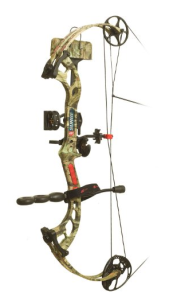 The PSE Surge RTS combines high performance with an awesome price. Although it’s below $500, it can shoot an impressive 320 FPS. What really impresses reviewers is that when compared to other 70 lb. draw weight bows, it feels effortless. If you’re willing to sacrifice a little FPS for accuracy, this is the right bow! Reviewers like that you get a lot more for the price, the shooting experience is wonderful, the vibration and noise are almost non-existent, and it has a smooth draw.
The PSE Surge RTS combines high performance with an awesome price. Although it’s below $500, it can shoot an impressive 320 FPS. What really impresses reviewers is that when compared to other 70 lb. draw weight bows, it feels effortless. If you’re willing to sacrifice a little FPS for accuracy, this is the right bow! Reviewers like that you get a lot more for the price, the shooting experience is wonderful, the vibration and noise are almost non-existent, and it has a smooth draw.
The specifications are as follows:
- 320 FPS
- 7.25” Brace Height
- 32.5” AtA
- 75% Let-Off
- 29” Draw Length
- 19.5-30” Draw Length Range
- 50/60/70 Pound Draw Weight Ranges
Best Compound Bow under $300
 If you’re looking to go even lower than $500, take a look at the Infinite Edge. The Diamond bows are manufactured by Bowtech, which is one of the world’s biggest archery suppliers. It’s the most versatile and best-selling compound bow out there, and the wide range of settings makes it great for beginners and experienced shooters alike. The draw length can be adjusted from 13” all the way up to 30,” and the draw weight can range from 5 pounds to 70 pounds. Unless you’re a giant, you can adjust this bow to just about anywhere for your liking. It can be used for hunting, and produces the necessary energy to take down large game from as far away as fifty yards.
If you’re looking to go even lower than $500, take a look at the Infinite Edge. The Diamond bows are manufactured by Bowtech, which is one of the world’s biggest archery suppliers. It’s the most versatile and best-selling compound bow out there, and the wide range of settings makes it great for beginners and experienced shooters alike. The draw length can be adjusted from 13” all the way up to 30,” and the draw weight can range from 5 pounds to 70 pounds. Unless you’re a giant, you can adjust this bow to just about anywhere for your liking. It can be used for hunting, and produces the necessary energy to take down large game from as far away as fifty yards.
The specifications are as follows:
- 310 FPS
- 13”-30” Draw Length
- 5-70 lb. Draw Weight
- 75% Let-Off
- 31” AtA
- 3.1 Pounds
Best Compound Bow under $200
For beginners, or those looking for inexpensive bows to develop skill, something under $200 will be sufficient.
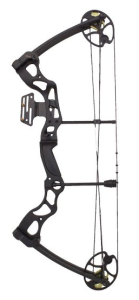 The SAS Rage is durable and high-quality for the price. It definitely gives you way more than you’d expect from an entry level bow. The materials used for the bow are high-quality and all standardized so you can easily replace them if necessary. This bow is an excellent bargain, and while it may not come from a top brand company, it still has a very good shot!
The SAS Rage is durable and high-quality for the price. It definitely gives you way more than you’d expect from an entry level bow. The materials used for the bow are high-quality and all standardized so you can easily replace them if necessary. This bow is an excellent bargain, and while it may not come from a top brand company, it still has a very good shot!
The specifications are as follows:
- 270 FPS
- 26-30” Draw Length
- 55-70 lbs. Draw Weight
- 70% Let-Off
- 35” AtA
- 4.4 Pounds
Best Compound Bow Brands
For those most concerned with high-quality brands that are reliable and pristine, the following is a list of the top three brands for compound bows, with the top seller for each brand.
PSE
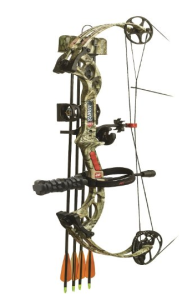
 PSE is notorious for claiming they’re the top compound bow brand in the world, and they have a lot of experience and knowledge to back it up. While they may look like they lack attention to detail in their design, what they lack in flashiness is made up for in the quality of their materials and their products.
PSE is notorious for claiming they’re the top compound bow brand in the world, and they have a lot of experience and knowledge to back it up. While they may look like they lack attention to detail in their design, what they lack in flashiness is made up for in the quality of their materials and their products.
Bear Archery

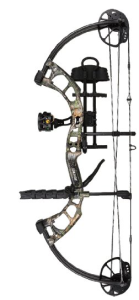 Bear Archery has been one of the top brands in compound bows for some time. Every year they reveal a new bow that hits the high scores. They put almost twenty new bows on the market in 2014 and released five new ones for 2015.
Bear Archery has been one of the top brands in compound bows for some time. Every year they reveal a new bow that hits the high scores. They put almost twenty new bows on the market in 2014 and released five new ones for 2015.
The Bear Cruzer definitely competes with the Diamond Infinite Edge when it comes to being adaptable. It has an adjustable draw length of 12-30”, and a draw weight of 5-70 lbs. This bow is perfect for growing archers and for female archers!
Martin Archery

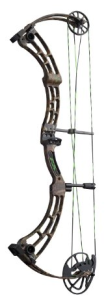 Martin Archery began in 1951 and almost went extinct a few years back, but they’re making an amazing comeback, and their bows are better than ever.
Martin Archery began in 1951 and almost went extinct a few years back, but they’re making an amazing comeback, and their bows are better than ever.
Diamond Archery

 Diamond Archery was actually bought by Bowtech, but they remain their own company with their own values and bow design. Diamond Archery prides themselves on being one of the highest-quality compound bow manufacturing companies while still maintaining affordable prices for their customers. One of their most popular bows is the Blackout.
Diamond Archery was actually bought by Bowtech, but they remain their own company with their own values and bow design. Diamond Archery prides themselves on being one of the highest-quality compound bow manufacturing companies while still maintaining affordable prices for their customers. One of their most popular bows is the Blackout.
The Blackout is one of the most impressive advancements of modern compound bow engineering. It has an FPS of 333. The draw weights are 50/60/70, and the let-off is 80%, making it easy to use. At only 3.8 pounds, it’s one of the most powerful, lightweight bows on the market, making it perfect for hunting.
Choosing the Right Compound Bow
Firstly, if you’re feeling unclear about the specifics of compound bows in general, I highly encourage you to check out this great Wikipedia entry on the subject. The page discusses compound bows, how they work, and compares them to other bow types. For those already familiar with these factors, let’s dive in.
When it comes to choosing the right compound bow for your needs, there are a few things you’ll want to keep in mind. For instance, whether you need a right-hand or left-hand bow, what draw weight will work best for your hunting scenarios, and the ideal draw length. In this section, I’m going to clear up any questions you may have about the elements of the compound bow. Later, we will discuss the right compound bow for beginners, youth, hunting, target shooting, and the overall value for the money.
Should you get a right-hand or left-hand bow?
 If you write with your right hand, you’re going to require a right-hand bow, and vis versa. Although straightforward, if you’re a beginner who has never shot a bow before, it might be confusing to orient yourself with the correct form.
If you write with your right hand, you’re going to require a right-hand bow, and vis versa. Although straightforward, if you’re a beginner who has never shot a bow before, it might be confusing to orient yourself with the correct form.
Right-hand bows are actually held in the left hand and pulled back with the right hand. A left-hand bow is going to be held in your right hand and pulled back with the left hand. Choosing your bow is based on the hand that is pulling back the bow and not the hand that is gripping the frame! The hand that pulls back the bow is the hand that is in control of aiming, which is why it should be your dominant hand.
What draw weight range do you need?
The draw weight of a bow comes in ten-pound increments. Some bows have more choices than others, but a typical bow will have choices of 40 to 50 pounds or 60 to 70 pounds. This means the bow can be adjusted to any draw weight between 40 and 50, such as 46, or 60 and 70, like 67. However, the first bow that has a weight of 40 to 50 pounds cannot be adjusted to 67, just like the second bow cannot be adjusted to 46.
If this is your first time shooting a bow, you will need to estimate a comfortable range. The following chart should give a bit of context, however, keep in mind that this is just an estimate and you may find that you need a bow that has a slightly smaller or larger weight range. The best way to figure out which one you need is to go to a local dealer and see what they suggest.
|
Age, Gender, and Weight |
Weight Range |
|
Small Child between 55 and 70 Pounds |
10-15 lbs. |
|
Small Child between 70 and 100 Pounds |
15-25 lbs. |
|
Child between 100 and 130 Pounds |
25-35 lbs. |
|
Small Woman between 100 and 130 Pounds |
25-35 lbs. |
|
Medium Woman between 130 and 160 Pounds |
30-40 lbs. |
|
Athletic Child between 130 and 150 Pounds |
40-50 lbs. |
|
Small Man between 120 and 150 Pounds |
45-55 lbs. |
|
Large Woman Above 160 Pounds |
45-55 lbs. |
|
Medium Man between 150 and 180 Pounds |
55-65 lbs. |
|
Large Man Above 180 Pounds |
65-75 lbs. |
You should note that in some states compound bows are required to meet a specific draw weight minimum in order to hunt larger game, such as deer. Be sure to check out your state’s particular rules and regulations.
In general to hunt larger game, such as a deer, a compound draw weight of 40 to 50 is sufficient. A draw weight of 50 to 60 is better for larger game.
While you’ll need a bow that is powerful enough to meet your needs, it’s also very important not to get a bow that is TOO heavy for you to use properly. Here is a video explaining more:
What draw length do you need?
The draw length of the bow determines how far it can be pulled back. To find a measurement, hold your arms at shoulder height away from your body as if you were going to hug a large tree. Keep them as straight as possible and have someone measure you from fingertip to fingertip. You shouldn’t be stretching, you should be comfortable. Take that number in inches and divide it by 2.5.
This amount is the approximate draw length for your body size.
If you’re someone of average proportions, your arm-span will likely be roughly equal to your height. However, if you’re someone who is particularly lanky or stocky, then the measured arm length will be more accurate.
If you’re unsure of the accuracy of your measurements, or if you’re in-between sizes, it’s best to go with the draw length that’s slightly less than your size, rather than a little more. Too much draw length will hinder accuracy and form, and might even lead to the unfortunate event of a painful string slap on your forearm. You will likely be more successful and enjoy the bow more if you choose the lower-end draw length.
What let-off setting do you need?
With a compound bow, the draw weight is going to decrease at the end of the draw stroke. This is known as a “let-off.” Your bow will come with a choice of low or high let-off options. When there is a higher let-off percentage, there will be less holding weight when the bow is fully drawn. This lets you have more time to aim without straining. A lower let-off is going to require that you hold more weight when the bow is fully drawn.
 Here are a few elements to consider to determine which would be better for you. The average archer is going to find the mid to high let-off bow more comfortable. That’s why it’s the most popular choice among new bows. In fact, some bows only come with a high let-off option, so you don’t get to choose. Be sure you read the bow’s description to see if you have an option at all.
Here are a few elements to consider to determine which would be better for you. The average archer is going to find the mid to high let-off bow more comfortable. That’s why it’s the most popular choice among new bows. In fact, some bows only come with a high let-off option, so you don’t get to choose. Be sure you read the bow’s description to see if you have an option at all.
There are some benefits you may want to consider if the low let-off option is available. A bow set at 65% let-off is going to shoot a few FPS faster than a bow that’s set at 80% let-off. In addition, if there is resistance when you are fully drawn, you will likely maintain alignment. Most avid bow hunters and competitors will argue that a bow at 80% let-off is too sloppy and too loose, and they prefer ones with low let-off options.
What type of arrows do you need?
It likely goes without saying that you can’t use your compound bow without arrows, so it’s necessary to know which ones will work best for specific uses. A “fletch” is the plastic material or the feathers at the end of the arrow that comes closest to your face. Let’s go over the different material options for the feathers, and their pros and cons.
It’s pretty obvious plastic vanes are going to be more durable than feathers. Vanes are best for youth archers and those who handle their equipment without a delicate touch. They are able to be crumpled and abused and usually still come back into shape. Since they can be fletched three different ways, they can be used with just about any style of arrow rest. Vanes are definitely the most popular choice for compound bow owners.
However, there are many who opt for feathers rather than plastic vanes. One big incentive is that they are almost three times lighter than plastic vanes. This means arrows made with feathers will fly faster and have a flatter trajectory. Feathers also add to a front-of-center balance, especially for hunters and competitors who are using lighter tips. Feathers are usually fletched in a helical configuration and have amazing stability for broadheads. However, you have to be careful how feathers are handled because they are easily ripped, ruffled, and tattered if not delicately preserved.
Vanes come in many different colors, and for good reason. While a deer is most likely not going to notice your orange vane, you are going to want to be able to find it if you miss. There are going to be times when your aim is not as accurate as you’d like, and you don’t want to be kneeling on the forest floor as you hunt through the leaves for your arrow. The colored plastic vanes offer greater visibility, and for this reason are highly valued among hunters.
Feathers will automatically get a helical turn. They have a natural twist, so they are fletched in a spiral style clamp. If you choose vanes, however, you will have to figure out if you want them to be straight, offset, or helical.
So what’s the difference?
Straight fletches will not rotate in flight. They have the fastest flying configuration, work well with any arrow rest, have the least amount of air resistance, and do not have fletching clearance problems. However, they are less stable when it comes to long-distance shooting, require a well-tuned bow, and have low broadhead stabilization.
Offset fletches will rotate a bit during flight. They have more stabilization when it comes to using broadhead arrows, work with most arrow rests, have very little loss of arrow velocity, and are stable at moderate distances. However, they do lose a bit of velocity and potentially have clearance issues while hunting.
Helical fletches will rotate dramatically in flight. They are preferred when it comes to using broadhead arrows as the tips tighten when you practice and they have the best long distance accuracy. Again, fletching clearance can be challenging and they have less arrow velocity.
It’s safe to say that the type of arrow you choose will depend on your preferences and priorities.
What is the nocking point system and which one should you use?
There are two different types of nocking systems commonly available on the market: the direct string with an e-button, and the string loop systems. The nocking system is where you fit the back end of the arrow into the bow string in order to pull it back and keep it steady.
A direct string with an e-button nocking system allows the operator to nock the arrow directly to the string of the bow. You can get a nocking system that has an e-button, which will provide cushion between the release and the nock of the arrow. This keeps the arrow from falling off the string when you’re at full draw, and will protect the nock from being damaged by the metal caliper.
The direct sting with an e-button is the better choice for longer axle bows.
A string loop is a good option if you want to hook the caliper release in a string loop. A brass nocking point is going to be installed and the arrow will be put just beneath it, in the string loop. This protects the bow from the abrasive effects of a metal caliper.
The string loop is the better choice for short axle bows.
Choosing Your Peep Sight
The peep sight serves the same purpose as the rear sight of a gun. The peep sight is a small, donut-shaped ring installed in the bow’s string. To aim, look through the peep sight hole when are you at full draw, and locate the front sight in the field of view. From here, place the pin on the intended target.
There are three different types of apertures for peep sights. They all have their pros and their cons, but most people choose the medium size because it gives them the best of both worlds. The smallest peep sight is 1/16” which gives the hunter or competitor the most accuracy, but challenging visibility. The medium size is 1/8” which provides good aim and is also easier to see through. The 3/16” has the most visibility, but is the worst for aiming.
Conclusion
Compound bows are light, versatile, and overall a wonderful piece of equipment for hunting and target practice. While there were many companies listed in this article, there are many more that you should explore to find the right compound bow for you. It’s out there, waiting for you to find it and take that first shot!

